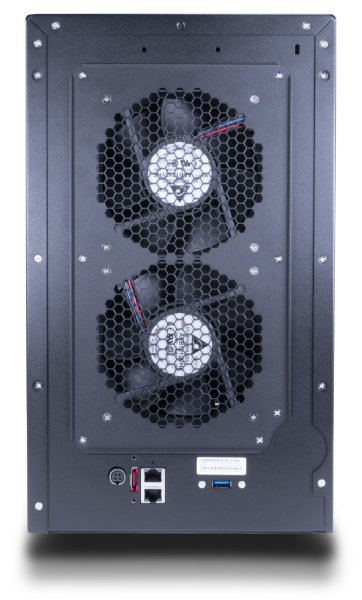What's in the box?:

The 1019+ that ioSafe sent us for this review did not come in fancy retail packaging. Instead, it came in a plain brown box with ioSafe logos in each corner. In addition to the 1019+, the box contained an AC power cord and adapter, ethernet cable, quick start guide, three bags of screws, a 3mm hex tool and a magnet to mount the tool on the back of the unit.

Physical Features:
The look of the 1019+ is very similar to ioSafe's previous 5-bay NAS, the 1515+. Designed to survive office and home fires, the device's outer layers are made from steel and measure 184 x 168 x 230 mm. The 1019+ also tips the scales at 29 kg (62 lbs) without any hard drives installed.

Instead of an LCD panel, the 1019+ uses a series of LED indicators to show the current state of the system and the installed hard drives. The brightness of these LEDs can be adjusted, or turned off altogether through the control panel within DiskStation Manager (DSM).

With the front doors removed, you can see some of the technologies the 1019+ utilizes to protect your data. In the middle is a sealed, aluminum chamber that uses HydroSafe technology to protect your hard drives from water damage. According to ioSafe, the 1019+ can be submerged up to 10 feet for 72 hours. Surrounding this chamber is a layer of ioSafe's DataCast fireproof insulation. This white, water-based insulation uses chemically bound water molecules that turn to steam during a fire. This steam is then forced out through a series of FloSafe vents to prevent heat and other dangerous gasses from entering the unit. This endothermic cooling action keeps the inner chamber cool despite outer temperatures over 1500°F.

The rear of the 1019+ is pretty straight forward. To keep the hard drives cool, the NAS is equipped with a pair of 120mm fans. By default, the fans are temperature controlled. However, you can manually set the speed from within DiskStation Manager. Below the fans, you can see the 1019+'s power connector, eSATA port, dual gigabit ethernet ports and another USB 3.0 port. These USB and eSATA ports can be used to connect expansion units, external storage devices, printers and other devices to the NAS.


Upgrading the memory and SSDs on the 1019+ is a quick and easy process. Instead of having to open up the case or remove the hard drives, ioSafe built a panel into the bottom of the device. Simply remove one screw, lift the compartment cover away and you have access to the RAM and M.2 slots. Take note though that, unlike the hard drives, these components are not protected against fire or water.

